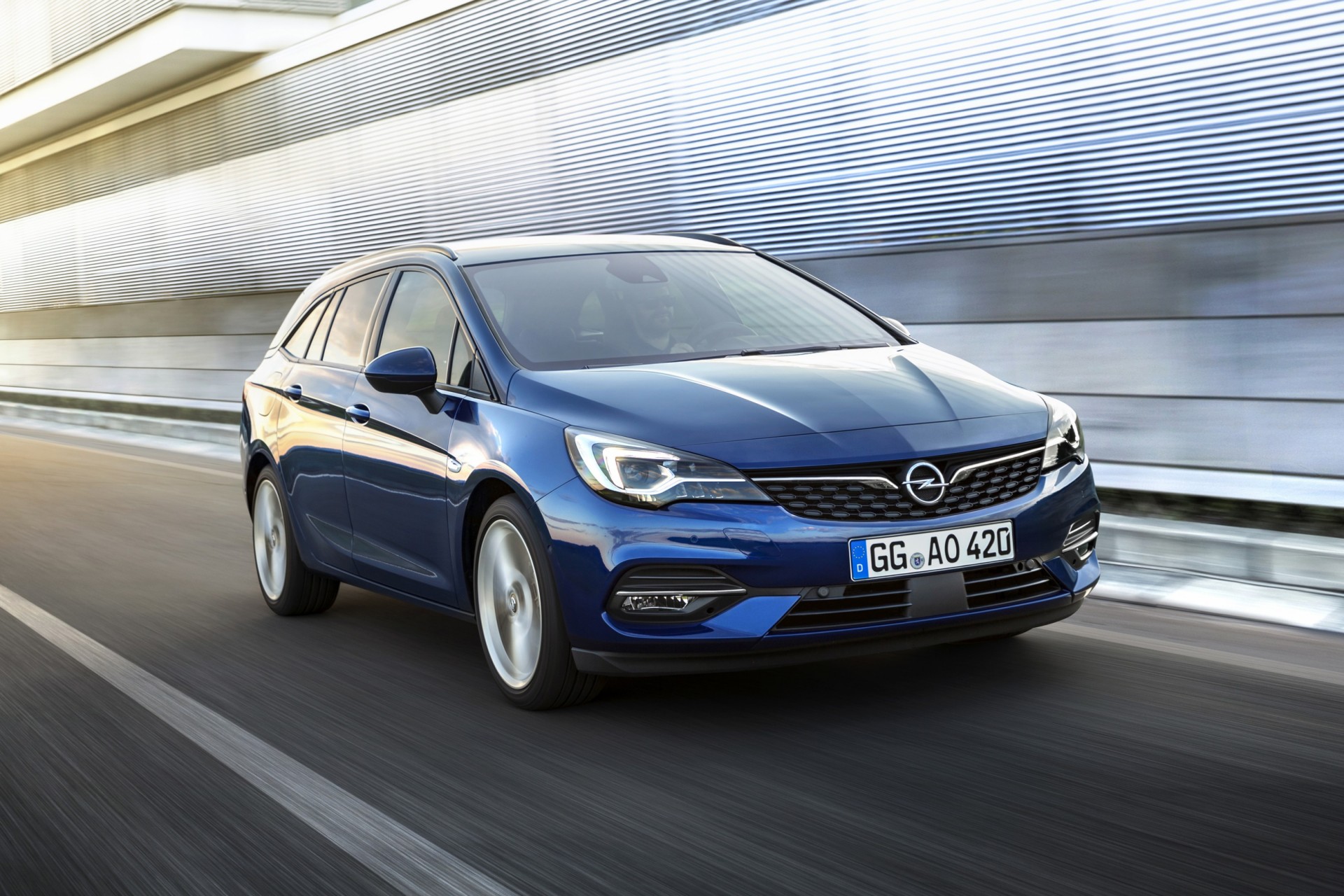2020 Debut for New Opel Astra
Published on 05th July 2019 at 11:20

Due to arrive at dealerships nationwide in January 2020, the new Opel Astra promises excellent aerodynamics, new lightweight design by some 200kgs, plus efficient new engines and transmissions, the new generation Opel Astra cutting the previous models CO2 emissions by up to 19 per cent.
This latest Astra five-door and Sports Tourer will be powered by the latest, new generation of efficient and lightweight petrol and diesel engines, with the 1.2-1.5-litre three-cylinder power units producing 77kW (105hp) to 107kW (145hp).
The Astra Sports Tourer and five-door Astra slip through the wind-stream with respective drag coefficients of 0.25 Cd, and 0.26 Cd. These aero-benchmarks have been achieved through numerous measures, including an engine compartment cover, deflector-shaped rear axle control arms and a full-face shutter. The upper and lower portions of the new Astra’s radiator grille automatically open and close independently of one another, further improving the frontal airflow. The underbody optimisation improves the drag coefficient by reducing turbulence.
The Astra’s dynamic chassis has been further developed, getting new shock absorbers for increased comfort and driveability. The optional sports chassis features stiffer dampers, a more direct steering and a Watts link at the rear axle.
Engines & Transmissions
The new turbocharged petrol and diesel engines promise low consumption and CO2 figures and run through modern six-speed manual gearboxes, a seven-speed continuously variable transmission (CVT) and – for the first time at Opel – a new nine-speed automatic.
The three-cylinder, turbo petrol units are available with 1.2 and 1.4-litre displacements, with power outputs ranging from 81kW (110hp) to 107kW (145hp) and maximum torque from 195 to 236 Newton metres. The Astra 1.2 is combined with a six-speed manual gearbox while the Astra 1.4 is available exclusively with a new seven-speed continuously variable transmission (CVT). With the CVT, drivers can enjoy the convenience of automatic gear changing or select gears themselves via the shift lever.
Integration of the water-cooled exhaust manifold in the cylinder head contributes to quick engine warm-up, which lowers emissions after a cold start.
| Petrol engines | 1.2 | 1.2 | 1.2 | 1.4 | |||||
| Power (kW/hp) @ rpm | 81/110 @ 4,500 | 96/130 @ 5,500 | 107/145 @ 5,500 | 107/145 @ 5,500 | |||||
| Torque (Nm @ rpm) | 195 @ 2,000-3,500 | 225 @ 2,000-3,500 | 225 @ 2,000-3,500 | 236 @ 1,500-3,500 | |||||
| Emissions | Euro 6d | Euro 6d | Euro 6d | Euro 6d | |||||
| Transmission | 6-speed manual | 6-speed manual | 6-speed manual | 7-speed CVT | |||||
| Preliminary NEDC1 fuel consumption (l/100 km) | |||||||||
| - Urban | 5.6-5.4 | 6.1 | |||||||
| - Extra-urban | 4.0-3.8 | 4.0 | |||||||
| - Combined | 4.6-4.4 | 4.8-4.7 | |||||||
| - CO2 g/km | 105-101 | 110 | |||||||
| Preliminary WLTP2 fuel consumption combined | |||||||||
| - l/100km | 5.5-5.2 | 5.9-5.7 | |||||||
| - CO2 g/km | 127-120 | 136-132 |
Astra turbo-diesel
The Astra’s 1.5-litre, three-cylinder diesel engines offer 77kW (105hp) and 90kW (122hp), with 260 to 300Nm of torque. The common rail fuel injection system operates at up to 2,000 bar.
| Diesel engines | 1.5D | 1.5D | 1.5D | ||||||
| Power (kW/hp) @ rpm | 77/105 @ 3,250 | 90/122 @ 3,500 | 90/122 @ 3,500 | ||||||
| Torque (Nm @ rpm) | 260 @ 1,500-2,500 | 300 @ 1,750-2,500 | 285 @ 1,500-2,750 | ||||||
| Emissions | Euro 6d | Euro 6d | Euro 6d | ||||||
| Transmission | 6-speed manual | 6-speed manual | 9-speed automatic | ||||||
| Preliminary NEDC1 fuel consumption (l/100 km) | |||||||||
| - Urban | 4.6-4.5 | 5.5-5.3 | |||||||
| - Extra-urban | 3.1 | 3.7-3.5 | |||||||
| - Combined | 3.6 | 4.3-4.2 | |||||||
| - CO2 g/km | 96 | 115-110 | |||||||
| Preliminary WLTP2 fuel consumption combined | |||||||||
| - l/100km | 4.7-4.4 | 5.3-4.9 | |||||||
| - CO2 g/km | 124-117 | 139-130 |
Compared to the previous model, the fuel consumption and CO2 figures of the 77kW (105hp) and 90kW (122hp) Astra diesels have been reduced by up to 17 per cent and around 10 per cent respectively.
New 9-speed auto
As an alternative to the six-speed manual gearbox, the most powerful diesel is optionally available with a new nine-speed automatic transmission, making the Astra the first Opel to be fitted with it.
The diesel engines feature an electrically-activated turbocharger with variable geometry turbine vanes (VGT) and, similar to their petrol counterparts, a balance shaft in the block for additional refinement. Likewise, the exhaust manifold is also integrated in the cylinder head.
Optimum exhaust after-treatment of the Astra 1.5 diesel is delivered by the emissions reduction system consisting of a passive oxidation catalyst, AdBlue injector, SCR catalyst and Diesel Particulate Filter (DPF).
New front and rear-view digital camera, plus a digital speedometer
The Opel Astra comes with their very impressive intelligent, glare-free IntelliLux LED matrix light units. Also included systems such as adaptive cruise control, following distance indication, forward collision alert with automatic emergency braking, traffic sign recognition and lane keep assist. Also available are Opel’s excellent AGR-certified (Aktion Gesünder Rücken e.V.) ergonomic seats with ventilation and massage function. The Astra also comes highly digitalised with a new optional high-tech front camera as well as rear view camera.
The new front camera is smaller, more powerful than before thanks to a faster processor. It now not only recognises vehicles, but also pedestrians – an important safety bonus. Thanks to the high-resolution camera, traffic sign recognition can now process more traffic signs and show them as symbols on the display. The digital rear-view camera available in conjunction with the new Multimedia Navi Pro infotainment system is also more powerful. The view of the traffic behind the vehicle on the monitor is more distinct and precise; the contrasts are more visible in the dark.
Astra customers can enjoy connectivity with the Apple CarPlay and Android Auto compatible systems Multimedia Radio, Multimedia Navi and Multimedia Navi Pro. They belong to the newest infotainment generation – smarter, faster and more intuitive. The top-of-the-line Multimedia Navi Pro – as in the Opel Insignia flagship – has an eight-inch colour touchscreen and can also be operated by voice control.
Connected Navigation services with real-time traffic information and online map updates make the journey more relaxed. The navigation display itself appears with redesigned symbols in a fresher, more modern look. The same applies to the instrument cluster: drivers in the new Opel Astra are the first to have a digital speedometer.
Optionally available is the E-Call emergency call function. If needed, help is alerted by pressing the red button. If the seatbelt tensioners or airbags are deployed, the system automatically makes an emergency call.
Wireless charging and Bose sound system
Compatible smartphones can now be charged inductively via wireless charging. All that’s required is to insert your smartphone into the opening provided in the centre console, making a flat battery is a thing of the past.
New Astra customers can opt for the Bose high-end sound system, coming with a total of seven loudspeakers including a RichBass subwoofer under the boot ensure optimum listening pleasure. In addition, up to eight different sound profiles can be stored via the digital amplifier – depending on the taste and preference of the music lover.
The 2019 Astra introduces a new heated windscreen, with fine, almost invisible wires in the windscreen that ensure a clear view of the road on frosty days and a fog-free journey.
